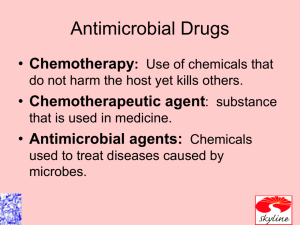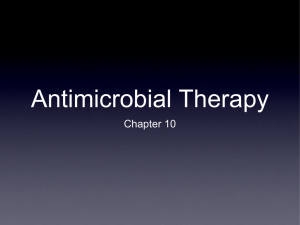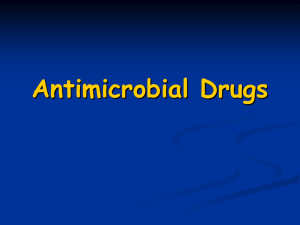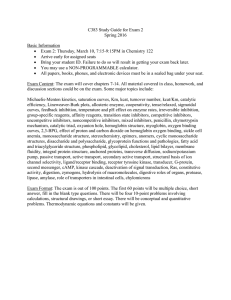Antimicrobial Drugs
advertisement
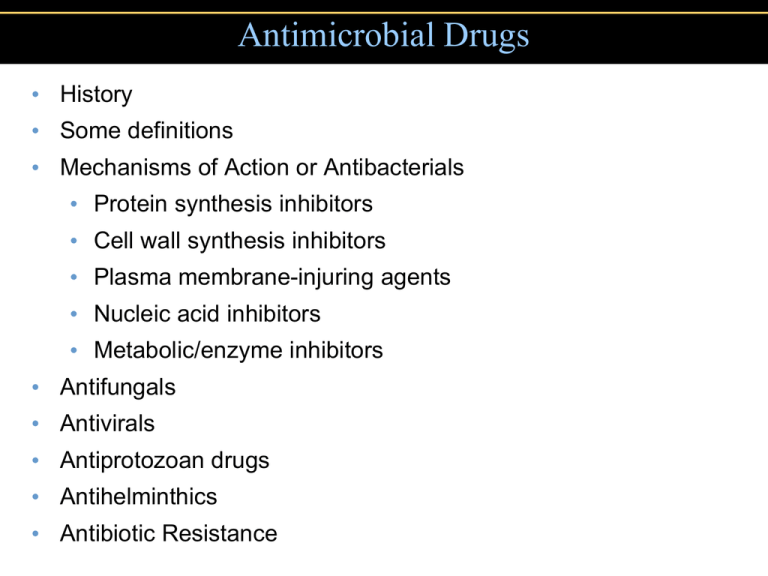
Antimicrobial Drugs • History • Some definitions • Mechanisms of Action or Antibacterials • Protein synthesis inhibitors • Cell wall synthesis inhibitors • Plasma membrane-injuring agents • Nucleic acid inhibitors • Metabolic/enzyme inhibitors • Antifungals • Antivirals • Antiprotozoan drugs • Antihelminthics • Antibiotic Resistance • 1928 – Fleming discovered penicillin, produced by Penicillium. • 1940 – Howard Florey and Ernst Chain performed first clinical trials of penicillin. Figure 20.1 Table 20.1 Definitions • Chemotherapy • Antimicrobial drugs • Antibiotic • Selective toxicity • Bacteriostatic/ bacteriocidal • Spectrum of activity between narrow vs. The use of drugs to treat a disease Interfere with the growth of microbes within a host Substance produced by a microbe that, in small amounts, inhibits another microbe A drug that kills harmful microbes without damaging the host Modes of action that either kill or inhibit growth Range of effect within or groups of microbes; broad-spectrum Table 20.2 Antimicrobial Drugs • History • Some definitions • Mechanisms of Action of Antibacterials • Protein synthesis inhibitors • Cell wall synthesis inhibitors • Plasma membrane-injuring agents • Nucleic acid inhibitors • Metabolic/enzyme inhibitors • Antifungals • Antivirals • Antiprotozoan drugs • Antihelminthics • Antibiotic Resistance The Action of Antimicrobial Drugs Figure 20.2 Protein Synthesis Inhibitors Figure 20.4 The Action of Antimicrobial Drugs Figure 20.2 Antibacterial Antibiotics Inhibitors of Cell Wall Synthesis: Penicilins • Penicillins • Natural penicillins: G, V • Semisynthetic penicillins • “-cillin “ suffix • Carbapenems • Monobactam Penicillins Figure 20.6 Antibacterial Antibiotics Inhibitors of Cell Wall Synthesis:Cephalosporins • Cephalosporins • 2nd, 3rd, and 4th generations more effective against gram-negatives Figure 20.9 Antibacterial Antibiotics Inhibitors of Cell Wall Synthesis: Polypeptides • Polypeptide antibiotics • Bacitracin • Topical application • Against gram-positives • Vancomycin • Glycopeptide • Important "last line" against antibiotic resistant S. aureus (e.g. MRSA) Antibacterial Antibiotics Inhibitors of Cell Wall Synthesis: Anti-Mycobacterials • Antimycobacterium antibiotics • Isoniazid (INH) • Inhibits mycolic acid synthesis • Ethambutol • Inhibits incorporation of mycolic acid The Action of Antimicrobial Drugs Figure 20.2 Antibacterial Antibiotics Injury to the Plasma Membrane • Polymyxin B • Topical • Combined with bacitracin and neomycin in overthe-counter preparation The Action of Antimicrobial Drugs Figure 20.2 Antibacterial Antibiotics Inhibitors of Nucleic Acid Synthesis • Rifamycin • Inhibits RNA synthesis by RNA polymerase • Antituberculosis • Quinolones and fluoroquinolones • Ciprofloxacin • Inhibits DNA gyrase so blocks DNA polymerase • Urinary tract infections The Action of Antimicrobial Drugs Figure 20.2 Antibacterial Antibiotics Competitive Inhibitors • Sulfonamides (Sulfa drugs) • Inhibit folic acid synthesis • Broad spectrum Figure 5.7 TMZ - Trimethoprim + Sulfamethoxazole: Synergism Figure 20.13 Antimicrobial Drugs • History • Some definitions • Mechanisms of Action or Antibacterials • Protein synthesis inhibitors • Cell wall synthesis inhibitors • Plasma membrane-injuring agents • Nucleic acid inhibitors • Metabolic/enzyme inhibitors • Antifungals • Antivirals • Antiprotozoan drugs • Antihelminthics • Antibiotic Resistance Antifungal Drugs Damage through Ergosterol • Leakage thorough binding ergosterol • Amphotericin B • Inibitors of Ergosterol Syntehsis • Miconazole, fluconazole • Triazoles Antifungal Drugs Inhibition of Cell Wall Synthesis • Echinocandins • Inhibit synthesis of glucan • Cancidas is used against Candida and Pneumocystis Other Antifungal Drugs • Inhibition of Nucleic Acids • Flucytocine: cytosine analog interferes with RNA synthesis • Pentamidine isethionate for Pneumocytis : binds to DNA • Inhibition of Mitosis (microtubule beakers) • Griseofulvin • Used for superficial mycoses • Tolnaftate • Used for athlete's foot; action unknown Antimicrobial Drugs • History • Some definitions • Mechanisms of Action or Antibacterials • Protein synthesis inhibitors • Cell wall synthesis inhibitors • Plasma membrane-injuring agents • Nucleic acid inhibitors • Metabolic/enzyme inhibitors • Antifungals • Antivirals • Antiprotozoan drugs • Antihelminthics • Antibiotic Resistance Antiviral Drugs Nucleoside and Nucleotide Analogs Figure 20.16a Antiviral Drugs Nucleoside and Nucleotide Analogs Figure 20.16b, c Antiviral Drugs Enzyme Inhibitors • Protease inhibitors • Indinavir • HIV • Inhibits attachment • Zanamivir • Influenza • Inhibits uncoating • Amantadine • Influenza • Interferons prevent spread of viruses to new cells • Viral hepatitis Antimicrobial Drugs • History • Some definitions • Mechanisms of Action or Antibacterials • Protein synthesis inhibitors • Cell wall synthesis inhibitors • Plasma membrane-injuring agents • Nucleic acid inhibitors • Metabolic/enzyme inhibitors • Antifungals • Antivirals • Antiprotozoan drugs • Antihelminthics • Antibiotic Resistance Antiprotozoan Drugs • Chloroquine • Inhibits DNA synthesis • Malaria • Diiodohydroxyquin • Unknown • Amoeba • Metronidazole (Flagyl) • Damages DNA after becoming toxic from fermentation enzymes • Entamoeba, Trichomonas, Giardia (no mitochondria!) • (also works on obligately anaerobic bacteria like Clostrdium) Antihelminthic Drugs • Niclosamide • Prevents ATP generation • Tapeworms • Praziquantel • Alters membrane permeability • Flatworms • Pyantel pamoate • Neuromuscular block • Intestinal roundworms • Mebendazole • Inhibits nutrient absorption • Intestinal roundworms • Ivermectin • Paralyzes worm • Intestinal roundworms Antimicrobial Drugs • History • Some definitions • Mechanisms of Action or Antibacterials • Protein synthesis inhibitors • Cell wall synthesis inhibitors • Plasma membrane-injuring agents • Nucleic acid inhibitors • Metabolic/enzyme inhibitors • Antifungals • Antivirals • Antiprotozoan drugs • Antihelminthics • Antibiotic Resistance: Natural Selection Population becomes increasingly resistant Bacteria Populations Under Sub-Lethal Selection Pressure Evolve to Become More Resistant 1. Every bacterial population has variations in resistance due to gene transfer among them and mutation. Resistance is coded by DNA. 2. Some variants survive a brief antibiotic challenge because of their resistance. 3. Survivors are the “parents” of the next generation and pass on their particular resistance genes in their DNA. 4. The next and subsequent generations are composed of many variants. As a whole, the population is more resistant than the last. Antibiotic Resistance • A variety of mutations can lead to antibiotic resistance. • Mechanisms of antibiotic resistance 1. Enzymatic destruction of drug 2. Prevention of penetration of drug 3. Alteration of drug's target site 4. Rapid ejection of the drug • Resistance genes are often on plasmids or transposons that can be transferred between bacteria. Antibiotic Resistance • Misuse of antibiotics selects for resistance mutants. Misuse includes: • Using outdated, weakened antibiotics • Using antibiotics for the common cold and other inappropriate conditions • Use of antibiotics in animal feed • Failure to complete the prescribed regimen • Using someone else's leftover prescription Effects of Combinations of Drugs • Synergism occurs when the effect of two drugs together is greater than the effect of either alone. • E.g. Sulfamethoxazole and trimethoprim • Penicillin with beta-lactamase inhibitor (clav. acid) • Alcohol and sleeping pills • Antagonism occurs when the effect of two drugs together is less than the effect of either alone. • E.g. Ibuprofen (anti-diuretic properties) + diuretic • Penicillin + streptomycin The Future of Chemotherapeutic Agents • Antimicrobial peptides • Broad spectrum antibiotics from plants and animals • Squalamine (sharks) • Protegrin (pigs) • Magainin (frogs) • Antisense agents • Complementary DNA or peptide nucleic acids that binds to a pathogen's virulence gene(s) and prevents transcription Antimicrobial Drugs • History • Some definitions • Mechanisms of Action or Antibacterials • Protein synthesis inhibitors • Cell wall synthesis inhibitors • Plasma membrane-injuring agents • Nucleic acid inhibitors • Metabolic/enzyme inhibitors • Antifungals • Antivirals • Antiprotozoan drugs • Antihelminthics • Antibiotic Resistance
